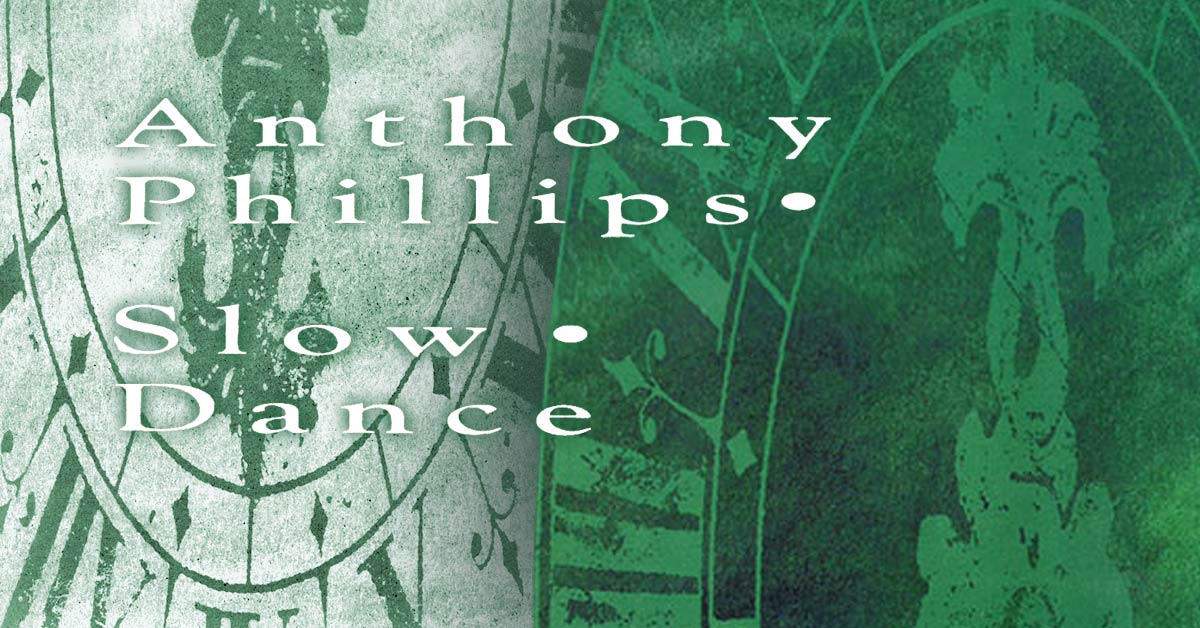- Article
- Read in 11 minutes
Anthony Phillips – Slow Dance – 2CD/DVD review
In 1990, Anthony Phillips has released is probably last full solo album Slow Dance. Tom Morgenstern takes a closer look on the album from his 2019 perspective.
Recorded in 1988-89 and released on September 24, 1990 as the first new album of his contract with Virgin Records, Slow Dance is probably Anthony Phillips’ last “real” solo album – with material composed and fully orchestrated for this purpose. All other albums after that consisted either of second exploitations of older pieces or only of simple, mostly solo instrumental sketches, most of which were not originally intended for an album context.
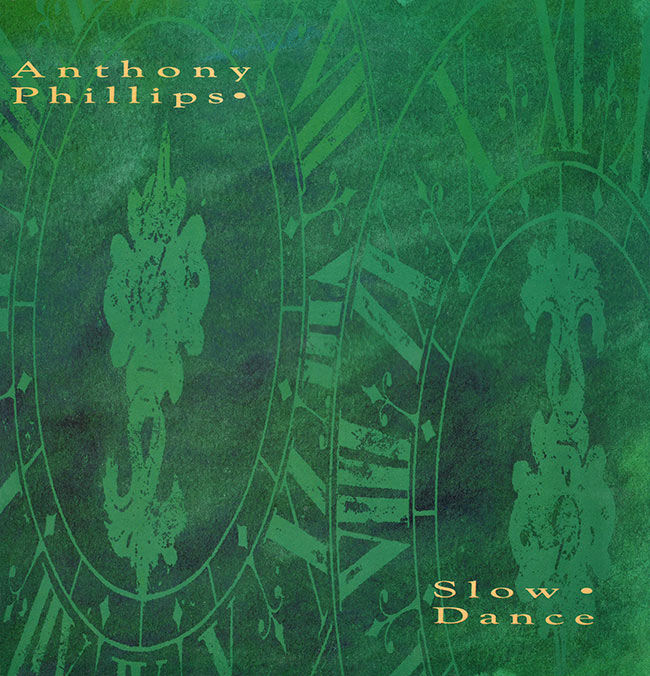
Slow Dance is the only one of his albums to be divided into two parts of the same name and about the same length, which, like a classical serenade, are each divided into four thematically different movements, each with its own arc of tension, without the boundaries of these parts being recognizable on the audio media, be it by intermediate grooves on the vinyl or track marks on the CD. The Slow Dance LP has two sides without visible subdivisions and the CD has exactly two tracks accordingly. The division into eight movements is therefore not an official one; it serves here only as an illustration.
The following is an attempt at an overview of the melodic-thematic components of the work. The names Lenta Chorum, “Single Demo” and No Way Out correspond to the themes of the individual titles of the same name on the bonus CD. The “Harp-Section” is mentioned in the credits.
Slow Dance (Part 1)
Movement 1: Lenta Chorum
0:00 The opening theme of the work begins with a restrained playing orchestra that cannot suppress the string synthesizers in the foreground. Underneath lies a strong, wind-like noise.
0:53 First use of synthetic nylon guitars, which pick up the theme and vary it, provided with a buzzing echo, which can’t improve this strongly artificial sound.
1:30 Now the flute picks up the same theme, accompanied by an organ-like synthesizer sound.
1:46 Second “guitar” part, the fast arpeggios make the synthetic sound even more unpleasant.
2:18 The theme is now picked up again by the orchestra and the flutes, albeit in a higher register, solemnly measured, but optimistic.
2:49 The theme turns into darkness, many ponderously dark chords and some strange key changes convey a now rather threatening mood.
3:14 The flutes now pick up the second guitar part melodically. It increases to the powerful finale of the first arc of tension – with chord variations of a versatility reminiscent of Tony Banks. Since most of the themes used in Lenta Chorum reappear later, mostly varying in arrangement, tempo and harmony, this first, almost self-contained part of the work can be seen as a kind of overture, even if important central themes are missing here.
Movement 2: „Harp-Section“
5:07 After the storm has faded away, things continue to calm down. The Speachi Quartet with harp, oboe, piccolo and clarinet invites you to the cultivated Volta. One circles in the gentle 3/4 time.
7:00 Short insertion of the strings, a simple descending melody is played through twice,
7:21 and then the Speachi Quartet theme is repeated.
7:45 Another string interlude, this time with the “single demo” theme, which is played here for the first time and also twice. Afterwards it leads directly to
8:08 a new flute theme, but here played by a synthesizer with harp pizzicatos underneath.
9:08 Speachi Quartet, part 3 and end of the second arc of tension.
Movement 3:
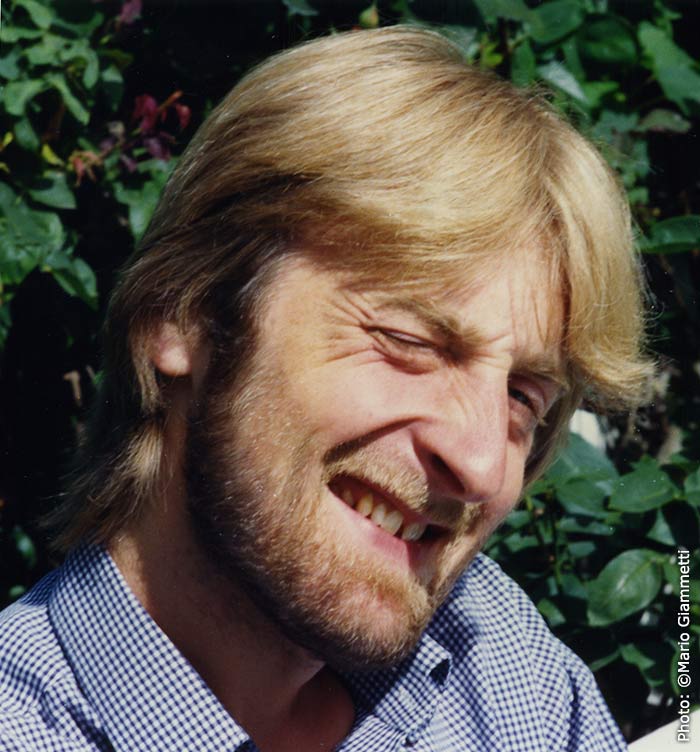
9:38 It sets in on the last note of the second movement with obstinately played eighth notes from a synthesizer. A monophonic synthesizer plays a simple solo on top. The piece increases slowly.
11:38 A chord change increases the tension, which
12:01 finally dissolves into a strongly rhythmic piece. Handclaps and various types of percussion leave little room for a Stratocaster solo that is pushed far into the background.
14:03 The rhythm stops abruptly and one hears a short variation of the Lenta Chorum chords before
14:26 finally an artificial choir sets in.
14:51 Behind the choir the timpani of the orchestra rumble, it ends on the dominant (A) without returning to the tonic (D).
Movement 4: Guitar Adagio
15:29 The Guitar Adagio theme starts right after that in D. Sparse, percussive synth sounds meet with beautiful real Stratocaster arpeggios.
16:33 With a surprising key change, the flute theme of 8:07 is repeated, but three semitones higher than before. A kind of synthetic glockenspiel finally leads over to the
17:09 “Single-Demo”-theme, here played by a soft flute sound and underlaid with synthetic guitar picking. From
17:42 on the orchestra gradually sets in.
19:29 The Lenta Chorum follows once more in a rapid pace with restrained instrumentation.
21:01 Reprise of the dark part of the Lenta Chorum, but it serves here only as a transition to the
21:22 Guitar Adagio-Reprise. We hear real drums for the first time and short but effective lines of the Stratocaster.
23:21 At the end the fake choir again, followed by a short harp part, which finishes the first part of the work rapidly and well defined.
Slow Dance (Part 2)
Movement 5:
0:00 A simple melody loop of glockenspiel and sequencer, plus a march-like snare drum open the second side of the album, it reminds a bit of the piece Preparation from the Camel album Snow Goose – not the worst template!
2:12 Followed by a longer ambient piece with floating synthesizer chords and several monophonic synths with reed-like sounds.
4:15 A slow driving rhythm, monotonous bass, shatter echoes on bass drum and snare, after more than a minute comes the first chord change.
6:10 The drums stop, only a headless tambourine rattles on quietly,
6:37 artificial chimes lead over to an
6:57 Oboe, who has to deal with terribly cheap-sounding orchestral hits,
7:27 until it is replaced by a few simple melodies. Everything ripples along, electronic drums, it sounds like the auto accompaniment from cheap home keyboards.
9:00 Four loud, slightly dissonant chord beats end this movement surprisingly.
Movement 6:
9:22 Begins with fast-flickering sequencers, then synthie flute, clarinet, a lead synth briefly plays the “single demo” theme. The orchestra begins, it sounds almost like film music, dramatic key changes, the main motif of the Lenta Chorum is briefly quoted again, then an abrupt end after four more loud beats, which sound like shots with their echoes this time.
12:15 A G# bass drone is built up, increases slowly, chords buzz around, then the apparent resolution to C, yet dissonances remain.
Movement 7: No Way Out
14:18 By far the most exciting arrangement of the album, electronic drums, the orchestra is in top form, a trumpet is used effectively, then the tension is released a bit, a quiet keyboard solo leads the piece back to the beginning.
17:34 The main theme of Lenta Chorum is briefly quoted again. A timid Stratocaster solo does not push itself into the foreground, which is a pity. From
17:45 on the “single demo” theme is picked up again.
18:39 Everything collapses. Only a flute sound insists on the No Way Out theme, behind it there are drum echoes, similar to Vienna by Ultravox.
Movement 8:
19:24 With the heavy opening chords of Lenta Chorum, this time played in slow motion, the last movement of the work begins.
21:15 Return to normal tempo. The flute picks up the theme again.
22:29 It changes somewhat abruptly to the opening theme from Movement 5 (the beginning of Side 2) – the flickering sequencer is missing, but there are delicate sounds of spheres and synth figures reminiscent of women’s voices, warm, conciliatory chords, light, percussive sounds almost become delicate choirs at the end – all instruments slowly ripple out and so the end of the work is almost like a long fade-out.
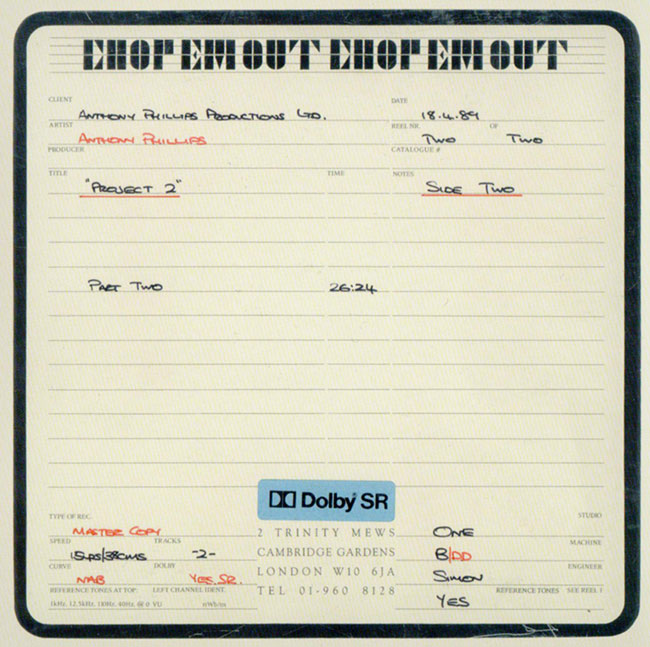
It could have been so good! – Anthony Phillips has paired many strong melodies with often surprising harmonies on this album, the arrangements are basically world class, the recording technique convinces by excellent dynamics – only with the instrumentation he unfortunately made it too easy too often. – Of course, at the end of the 1980s digital synthesizers with the cheesiest preset sounds, which couldn’t really be changed, were widely used – you were used to the sound of a Yamaha DX-7 or its close relative Casio CZ 5000. In the booklet Anthony still praises this synthesizer, especially this “super flute sound, which you wouldn’t know it’s a synth” – sorry, dear Ant, but the wrong flute can be recognized even without classical training!
Admittedly, these sounds were ultra-modern back then – that’s how the upcoming “New Age” music sounded – they now unfortunately seem rather dusty and are immediately associated with the “Eighties” or the panpipe-playing Indians in pedestrian zones. Today they can only be found in cheap solo entertainer keyboards. Unfortunately at many places the album sounds as if it had been recorded with such equipment.
The use of the primitive and (comparatively) inexpensive sampler Emax by the company E-mu (whose high-price product “Emulator” was much more popular and better) was probably the biggest mistake Anthony Phillips made here. We owe to this device the many simply bad sounding nylon guitars – which Ant would have played better as real instruments. He once confessed to me that he had been too lazy to sit down and practice the parts on real guitars.
After all, an older, fully analog Roland Jupiter 8 synthesizer is also listed in the booklet. Fortunately it was used for the warm string sounds and the full chords in the background, so at least these passages, often overlaid with the orchestra, sound outstandingly good.
But it’s not just the sounds – real instruments have indeed been used, unfortunately they are mostly mixed into the background and often hardly audible. So over long passages the album doesn’t sound much better than the nightly sleep-entertainment of radio stations for seniors.
On Anthony Phillips’ discharge: The recordings were difficult and technically ambitious at the time. A borrowed, semi-professional Fostex 16-track machine did bring a little creative freedom, but he recorded [most of] the album without clicktrack or other synchronisation settings, so he had to record each part of each instrument one after the other in the intended order. When everything was almost finished, co-producer Simon Heyworth couldn’t help suggesting real strings (which doesn’t surprise me at all). Of course, this required more tracks, so a second 16-track machine was connected and the orchestra was recorded in London’s CBS studios. But more tracks required more hands for mixing (there was no automation in Ants home studio).
Fortunately, he kept finding people to help him. Also financially, because since the bankruptcy of his US label Passport he had no record contract and therefore no advance payments. Luckily, he finally signed to Virgin Records with the finished album, who also wanted to re-release his back catalogue (and for the first time on CD). Slow Dance was the first to be released – and became a success – especially to his fans.
But it could have been much better! – How much better, is shown by some of the tracks on the bonus CD, which is included in the appealingly designed five-panel digipack and which was given the title “Slow Dance Vignettes”. Especially the two alternative mixes of No Way Outclearly show how great things could have been produced with the simplest means:
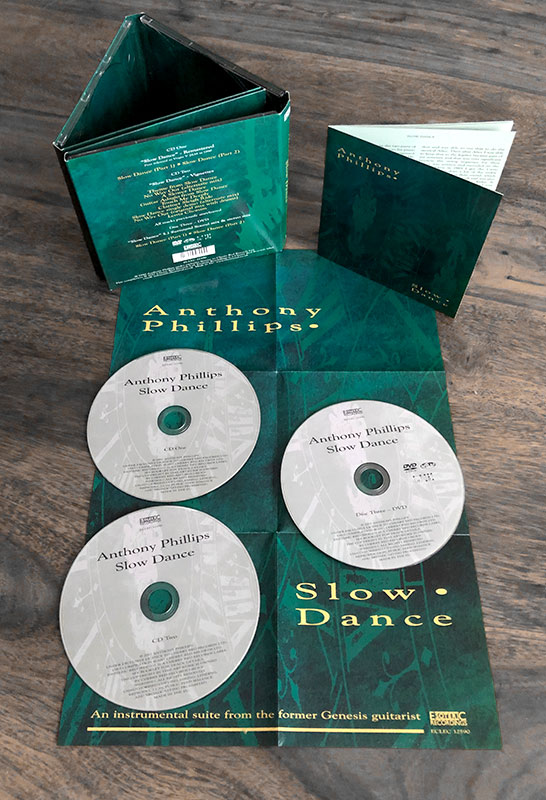
Themes from Slow Dance
summarizes the most important orchestra motives of the album in a three and a half minute suite, very well recorded, crystal clear sound
No Way Out (alternate mix)
My favourite of the bonus CD – this is how Slow Dancecould have sounded if they had placed the acoustic guitars in the foreground. Anthony Phillips doesn’t play breakneck stuff here, just comparatively simple arpeggios, but it’s a real nylon guitar, a blessing with which the orchestra harmonizes perfectly.
A Slower Dance
This is a kind of short version of Slow Dance. Unfortunately, with a somewhat rigid electro rhythm and a sequencer jingle that gets annoying at some point, the most important Slow Dance themes are lined up in five and a half minutes. Forgetable.
Guitar Adagio from Slow Dance
Here they have produced a new mix of the finale of Part 1 (from about 21:22), again with the emphasis on the excellently played melody lines and arpeggios of Anthony’s Stratocaster, which unfortunately is lost a bit in the original mix..
Touch Me Deeply (demo)
Seems pretty familiar to me, without me being able to identify the piece spontaneously. Just a very catchy demo that was recorded during the album sessions. Dominant instrument is a piano, unfortunately plastered with cheesy synthie chords. Ends in a fade-out where you might think you can spot a guitar from time to time.
Clarinet Sleigh Ride
is the second of these side demos. Apart from the temporal aspect, there is no relation to Slow Dance either. Besides the eponymous (synthetic) clarinet a rather monotonous sequencer dominates. When the clarinet plays, the title fits. Unfortunately it is way too long.
Slow Dance single demo (alternate mix)
For a possible single release, a single-mix was made as a precautionary step at the time, using the main theme from page 1, which can be heard for the first time at 7:45 min, but here it is enriched with synthetic drums and percussions as well as the cheesiest synth sounds imaginable. The Sound of Muzak, awful! – The demo was already on the first Archive Collection CD, but here is a remix with a little more emphasis on the keyboards (as if that would have been necessary…). Of course, Virgin didn’t like the single idea so much, so it led to nothing.
No Way Out (original mix with drums)
Actually, they had recorded real drums with Ian Thomas for this climax of the album, but later decided to drop them – you have to imagine that! – However, the way this track is mixed, you can almost understand that. Instead, if they had put the drums in the foreground a bit more spectacular, this would have served the piece well.
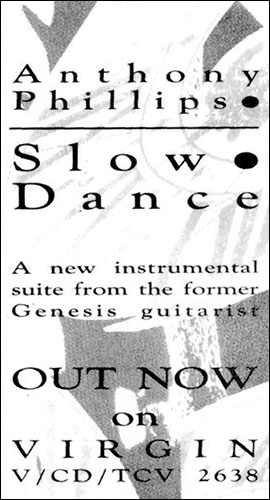
Lenta Chorum
Here we once again get the theme with which Slow Dance begins and ends, presented as the sole orchestral version. Powerfully played, unfortunately very short.
With not even 32 minutes running time, the “vignettes” are somewhat short overall. I could have loved a few more alternative mixes here. Also, the Slow Dance-Outtake The Burnt-Out Cattle Truck Hits The Road would have fitted well here, even if it’s not very important and has already been released on Archive Collection Vol. 1.
Finally, a comment on the 5.1 mixing contained on the DVD of this edition in dts and Dolby Digital: this one is quite conservative and therefore not very courageous. Unfortunately, you can say if you had wished that the guitars could have come out better. Fortunately, you can say if you want to listen to the album, as you have known it for almost 30 years, just a bit more spatially.
That’s pretty much all they did; there are no isolated instruments in the surround channels, only the reverb tails. In view of the potential of this album and the extremely well done remixes on the bonus CD, I rather tend to find this a little unfortunate..
Author: Tom Morgenstern
Slow Dance is available on 2CD/DVD Digipak (2017 re-release) on amazonUK, Cherry Red and digitally on iTunes.
You may discuss Slow Dance with other fans in our forum at this link.

